Oxygyrus inflatus
Roger R. SeapyIntroduction
Along with Atlanta peronii, Oxygyrus inflatus attains the largest shell size (diameter to 10 mm) in the family Atlantidae. The larval shell is calcareous and displays a distinctive pattern of evenly-spaced, zigzag-shaped spiral ridges oriented in the axis of shell growth and covering the shell surface. Unlike all other atlantids, the adult shell (teleoconch) is composed of a cartilaginous material, conchiolin. With growth the teleoconch overgrows the larval shell (protoconch), eventually surrounding it. An exposed shell spire, as seen in all other atlantids, is lacking and the spire is termed involute. The keel is glass-like, composed of conchiolin, and has a truncate anterior edge. The eyes are type c; characterized by a solid black, cup-shaped base. The operculum is unique among atlantids, with a broadly triangular shape (approaching trapezoidal) and lacking an apical gyre. The radula is type I, very large, with an elongate, triangular shape. The central (rachidian) tooth bears three cusps, in contrast with the single median cusp seen in all other atlantids. The geographical distribution is cosmopolitan in tropical to subtropical waters.Diagnosis
- Larval shell (protoconch) calcareous, with evenly-spaced, zigzag-shaped ridges that are oriented in the axis of shell growth and cover the shell surface
- Adult shell (teleoconch) and keel cartilaginous, composed of conchiolin
- Shell spire involute
- Eyes type c, with a solid black, cup-shaped base
- Operculum broadly triangular, nearly trapezoidal in shape, and lacks a gyre region
- Radula type I; large with an elongate, triangular shape
- Central (rachidian) tooth with three cusps
Characteristics
- Shell
- Larval shell calcareous with evenly-spaced, zigzag-shaped spiral ridges oriented in the axis of shell growth and covering the shell surface
- Adult shell and keel cartilaginous, composed of conchiolin. The adult shell overgrows the larval shell and eventually covers it except for the central portion, represented by the involute spire
 Click on an image to view larger version & data in a new window
Click on an image to view larger version & data in a new window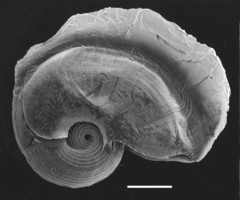
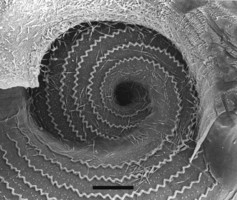
Figure. Scanning electron micrographs of the shell of a young Oxygyrus inflatus (shell diameter = 2.2 mm), viewed from the right side at low (left) and high (right) magnifications. Scale bar = 0.5 and 0.1 mm, respectively. © Roger R. Seapy
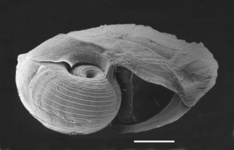

Figure. Scanning electron micrographs of the shell of Oxygyrus inflatus viewed at about a 60° tilt at low (left) and high (right) magnifications. Scale bars = 0.5 and 0.1 mm, respectively. Note that the critical point drying method used to prepare the specimen for examination resulted in a slight elevation of the base of the teleoconch from the underlying protoconch. ©
- Larval shell calcareous with evenly-spaced, zigzag-shaped spiral ridges oriented in the axis of shell growth and covering the shell surface
- Eyes type c, distinguished by a solid black, cup-shaped base that holds the spherical lens. This eye type is found in only two other species of heteropods, Atlanta helicinoidea and the Cardiapoda richardi
 Click on an image to view larger version & data in a new window
Click on an image to view larger version & data in a new window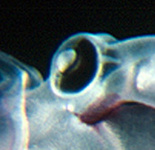
Figure. Right eye in Oxygyrus inflatus. Photo from an enlarged portion of the title illustration. ©
- Operculum broadly triangular, approaching trapezoidal, and lacks an apical gyre; unique among the atlantids. Also unlike other atlantids, only one-half of the aperture is covered by the operculum when the animal retracts into its shell (Richter and Seapy, 1999)
- Radula
- Radula type I; considerably larger than in other atlantids, with an elongate triangular shape and a broad base
- Central tooth tricuspid, with the three cusps of equal length in juveniles, but with the median cusp substantially longer in adults
- Lateral teeth (innermost tooth in the juvenile and adult radulae below) with a strong process on the inner side that bears an accessory cusp. The process and cusp become larger in adults. The pair of marginal teeth are monocuspid and become more strongly hooked distally in adults
- Radula type I; considerably larger than in other atlantids, with an elongate triangular shape and a broad base
- Larva
- Larval tissues posterior to the head region light bluish-purple; digestive gland brown
- Larval shell with evenly-spaced, zigzag-shaped spiral ridges that run parallel with the axis of coiling and cover the shell surface
- Embryonic portion (protoconch I) of the larval shell low and dome-shaped (see the SEMs below). The embryonic shell is only seen in early larvae because it is subsequently overgrown by protoconch II. In the three sketches below protoconch II can be seen to progressively override and eventually completely overgrow protoconch I. The result is that an exposed spire (as seen in all other atlantids) is lacking in adults, and the spire is termed involute
- Larval tissues posterior to the head region light bluish-purple; digestive gland brown
Comments
Taxonomy: This species has been recognized as Oxygyrus keraudreni (Lesueur, 1817) for over a century by all but a few authors; despite the fact that two early workers (d'Orbigny, 1835, and Souleyet, 1852) had shown that what Lesueur had described as Atlanta Keraudrenii was not a species of Atlanta. Both authors, however, politely continued to use Lesueur's well-known name and authorship for reasons of 'nomenclatural stability'. Erroneously interpreting the name Atlanta Keraudrenii Lesueur, Rang (1827) was the first to describe and illustrate the species now known as Oxygyrus keraudreni.
The generic name Oxygyrus was introduced in 1835 by Benson. Following a lengthy description of the genus, and at the very end of the paper, Benson named the species Oxygyrus inflatus with a very brief description in Latin and English:
"It only remains to give the specific character of Oxygyrus. O. inflatus. Shell tumid, whorls transversely and closely striate; sutures deeply cut."
Interestingly, Benson referred to neither Lesueur (1817) nor Rang (1827) in his paper. Fifteen years after Benson's publication, Gray (1850, p. 101) merged Lesueur's specific epithet with Benson's genus to create Oxygyrus keraudreni, which he then attributed to Lesueur! Based on Benson's short description of O. inflatus, and overlooking the preceding 2-1/2 pages of Benson's generic description, Tesch (1906) was unable to interpret the species name, and two years later in his 1908 review of the taxonomy of the family Atlantidae, Tesch (p. 5) included "O. inflatus? Benson" in his list of synonyms for O. keraudreni, but with no explanation or further discussion. Since the latter paper there have only been two authors (Thiele, 1929 and Wenz, 1941) who have recognized O. inflatus as the type species of Oxygyrus.
The preceding discussion is based on an as-yet unpublished manuscript by Arie W. Janssen, graciously provided to R. Seapy. Janssen is of the opinion that the original description of Atlanta keraudreni by Lesueur (1817) refers to a juvenile Atlanta species, most probably A. peronii (Lesueur, 1817). As noted above, the specific epithet keraudreni has persisted until the present as Oxygyrus keraudreni (Lesueur, 1817), which has been used by nearly all authors over the past century. To avoid all possible future uncertainties, Janssen intends to designate a neotype for Lesueur's taxon, making it a synonym of Atlanta peronii. And, Oxygyrus inflatus Benson, 1835 must now be recognized as the valid species name.
Ecology: The abundance of Oxygyrus inflatus differed dramatically in studies from the northwestern Indian Ocean and the North Pacific off Hawaii. In a paper by Richter (1974) on heteropods collected from the Meteor Expedition in the Indian Ocean, O. inflatus was moderately abundant, ranking fifth of sixteen atlantid species and accounting for 8.7% of the total species numbers. However, in three studies from Hawaiian waters off leeward Oahu it occurred in extremely low numbers. Based on species counts from five plankton cruises (Seapy, 1990a), it ranked last among thirteen species and represented 0.2% of the total numbers collected. In a diel vertical distribution study (Seapy, 1990b) it ranked last of eleven species, accounting for 0.6% of the total mean abundances. And, in a seasonal diel vertical distribution study it was not recorded in a fall sampling period and was last among fifteen species in the spring, accounting for 0.1% of the total mean nighttime densities.
Three studies of vertical distribution have shown that O. inflatus is a shallow-dwelling species, found mainly in the upper 50 m of the water column. In the tropical Atlantic Ocean Richter (1982) reported that it was almost entirely limited to the upper 100 m of the water column, with 89% of specimens collected from 0-50 m. In a diel study off leeward Oahu (Seapy, 1990b) it was limited to the upper 90 m, with only two individuals collected during the day between the surface and 45 m, and with one individual from 45-90 m and six from 0-45 m at night. A subsequent diel study (Seapy, 2008) was conducted from the same area as the previous one, but included fall and spring sampling periods at stations at 1, 5, and 15 nmi from shore. In the spring it was only collected in nighttime tows from 0-20 m at the 5 nmi station. The absence or near absence from daytime tows in the two studies above suggest the possibility of daytime net avoidance.
References
Benson, W. H. 1835. Account of Oxygyrus; a new genus of pelagian shells allied to the genus Atlanta of Lesueur, with a note on some other pelagian shells lately taken on board the ship Malcolm. Journal of the Asiatic Society of Bengal 4: 173-176.
Gray, J. E. 1850. Catalogue of the Mollusca in the collection of the British Museum, 2. Pteropoda. British Museum/E. Newman, London. 45 pp.
Janssen, A. W. In Prep. Late Quaternary to Recent holoplanktonic Mollusca (Gastropoda) from the eastern Mediterranean: systematics, morphology and palaeogeographical implications (provisional title, intended to be published eventually in Bollettino Malacologico).
Lesueur, [C. A.] 1817. Mémoire sur deux nouveaux genres de mollusques, Atlante et Atlas. Journal de Physique, de Chimie, et d'Histoire naturelle 85: 390-393, 2 plates.
Orbigny, A. d'. 1834-1847. Voyage dans l'Amérique méridionale (le Brésil, la république orientale de l'Uruguay, la république Argentine, la Patagonie, la république du Chili, la république de Bolivia, la république du Pérou), exécuté pendant les années 1826, 1827, 1828, 1829, 1830, 1831, 1832 et 1833, 5. Bertrand and Strasbourg, Levrault, Paris. pp. 49-72, 129-176, pls. 3-8, 17-23, 25, 55 (1835).
Rang, [P. C. A. L]. 1827. Observations sur le genre Atlante. Mémoires de la Société d'Histoire naturelle de Paris 3: 372-381, pl. 9, figs. 4-6 and 8.
Richter, G. 1961. Die Radula der Atlantiden (Heteropoda, Prosobranchia) und ihre Bedeutung für die Systematik und Evolution der Familie. Zeitschrift für Morphologie und Ökologie der Tiere 50: 163-238.
Richter, G. 1968. Heteropoden und Heteropodenlarven im Oberflächenplankton des Golfs von Neapel. Pubblicazioni della Stazione Zoologica di Napoli 36: 346-400.
Richter, G. 1974. Die Heteropoden der "Meteor" Expedition in den Indischen Ozean 1964/65. "Meteor" Forschungs-Ergibnisse Ser. D, No. 17, pp. 55-78.
Richter, G. 1982. Mageninhaltsuntersuchungen an Oxygyrus keraudreni (Lesueur) (Atlantidae, Heteropoda). Beispiel einer Nahrungskette im tropischen Pelagial. Senckenbergiana Maritima 14: 47-77.
Richter, G. and R. R. Seapy. 1999. Heteropoda, pp. 621-647. In: D. Boltovskoy (ed.), South Atlantic Zooplankton. Backhuys Publishers, Leiden.
Seapy, R. R. 1990a. The family Atlantidae (Gastropoda: Heteropoda) from Hawaiian waters: a faunistic survey. Malacologia 32: 107-130.
Seapy, R. R. 1990b. Patterns of vertical distribution in epipelagic heteropod molluscs off Hawaii. Marine Ecology Progress Series 60: 235-248.
Seapy, R. R. 2008. Offshore-inshore and vertical distributional patterns of heteropod mollusks off leeward Oahu, Hawaii. Marine Biology 154: 985-995.
Souleyet, [L. F. A.] 1852. Heteropodes, pp. 289-392. In: [J. F. T. Eydoux] and [L. F. A.] Souleyet, Voyage autour du monde exécuté pendant les années 1836 et 1837 sur la corvette 'La Bonite', commandée par M. Vaillant, capitaine de vaisseau, publié par ordre du Gouvernement sous les auspices du Département de la marine. Zoologie, 2. Atlas. A. Bertrand (ed), Société de Géographie, Paris.
Spoel, S. van der. 1976. Pseudothecosomata, Gymnosomata and Heteropoda (Gastropoda). Bohn, Scheltema and Holkema, Utrecht. 484 pp.
Tesch, J. J. 1906. Die Heteropoden der Siboga-Expedition. Monograph 51, 112 pp, 14 plates. E. J. Brill, Leiden.
Tesch, J. J. 1908. Systematic monograph of the Atlantidae (Heteropoda) with enumeration of the species in the Leyden Museum. Notes from the Leyden Museum 30: 1-30, 5 plates.
Thiele, [K. H.] J. 1929. Handbuch der systematischen Weichtierkunde, Fischer, Jena 1(1): 1-376.
Thiriot-Quievreux, C. 1973. Heteropoda. Oceanography and Marine Biology Annual Review 11: 237-261.
Wenz, W. 1941. Handbuch der Paläozoologie, 6. Gastropoda, 1. Allgemeiner Teil und Prosobranchia, 5. Bornträger, Berlin. pp. 961-1200.
About This Page

California State University, Fullerton, California, USA
Correspondence regarding this page should be directed to Roger R. Seapy at
Page copyright © 2011
 Page: Tree of Life
Oxygyrus inflatus .
Authored by
Roger R. Seapy.
The TEXT of this page is licensed under the
Creative Commons Attribution License - Version 3.0. Note that images and other media
featured on this page are each governed by their own license, and they may or may not be available
for reuse. Click on an image or a media link to access the media data window, which provides the
relevant licensing information. For the general terms and conditions of ToL material reuse and
redistribution, please see the Tree of Life Copyright
Policies.
Page: Tree of Life
Oxygyrus inflatus .
Authored by
Roger R. Seapy.
The TEXT of this page is licensed under the
Creative Commons Attribution License - Version 3.0. Note that images and other media
featured on this page are each governed by their own license, and they may or may not be available
for reuse. Click on an image or a media link to access the media data window, which provides the
relevant licensing information. For the general terms and conditions of ToL material reuse and
redistribution, please see the Tree of Life Copyright
Policies.
- First online 06 October 2008
- Content changed 23 July 2011
Citing this page:
Seapy, Roger R. 2011. Oxygyrus inflatus . Version 23 July 2011. http://tolweb.org/Oxygyrus_inflatus/28753/2011.07.23 in The Tree of Life Web Project, http://tolweb.org/





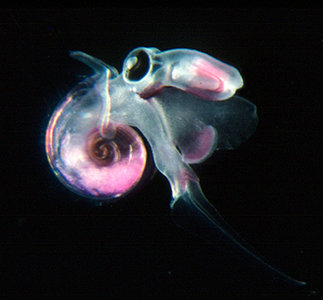
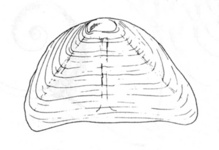
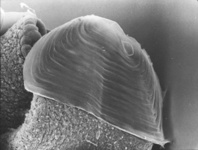
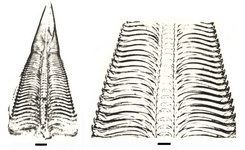
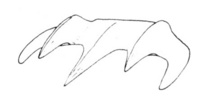

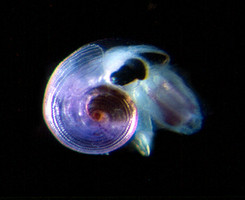
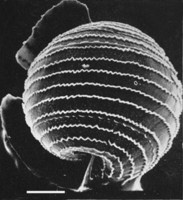
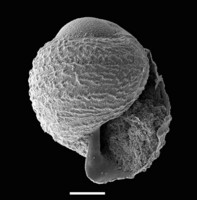
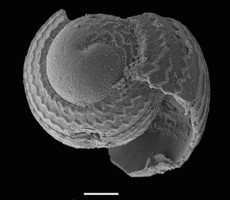
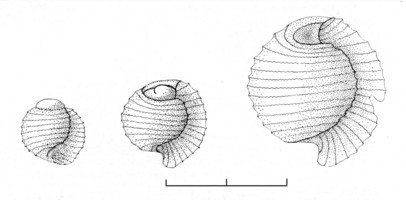



 Go to quick links
Go to quick search
Go to navigation for this section of the ToL site
Go to detailed links for the ToL site
Go to quick links
Go to quick search
Go to navigation for this section of the ToL site
Go to detailed links for the ToL site